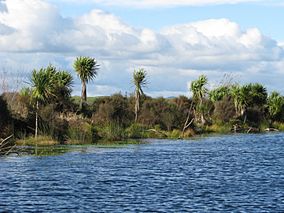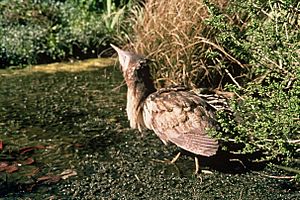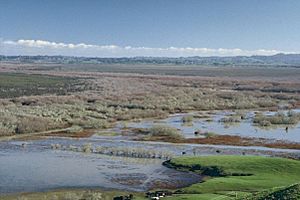Whangamarino Wetland facts for kids
Quick facts for kids Whangamarino Wetland |
|
|---|---|

Whangamarino Wetland looking at vegetation from the Reao Stream
|
|
| Location | Waikato District, New Zealand |
| Area | 5,923 hectares (14,640 acres) |
| Official name: Whangamarino | |
| Designated: | 4 December 1989 |
| Reference #: | 443 |
The Whangamarino Wetland is a huge natural area in the Waikato District of New Zealand. It's the second largest wetland of its kind on the North Island. This special place covers over 7,200 hectares. A big part of it, about 5,923 hectares, is looked after by the Department of Conservation (also known as Te Papa Atawhai). This area includes different types of wet lands like peat bogs, swamps, and rivers. It's so important that it's listed as a wetland of international importance under the Ramsar Convention.
Another large part of the wetland, 748 hectares, is managed by Fish and Game New Zealand. They mainly use their section for hunting gamebirds. The Whangamarino Wetland is also one of three top wetlands in New Zealand that are part of the Arawai Kākāriki wetland restoration program. This program helps bring wetlands back to health. It also encourages local people to get involved and supports research into how to best restore these important natural areas.
Contents
Amazing Plants and Animals
The Whangamarino Wetland has many different types of ecosystems (natural communities of living things and their environment). These include peat bogs, swamps, and river systems. This variety is one reason why it's so important and was given its special Ramsar listing.
Wetland Plants
You can find 239 different kinds of wetland plants in Whangamarino. About 60 percent of these are native to New Zealand. Some of these plants are very rare or hard to find anywhere else. For example, there's the water milfoil (Myriophyllum robustum) and the clubmoss (Lycopodium serpentinum). The critically endangered swamp helmet orchid (Corybas carsei) is now only found in this wetland!
The main plants in the peat bogs are Baumea species, mānuka (Leptospermum scoparium), and wire rush (Empodisma minus). The swamp areas have even more types of plants. Some plants that are not native, like grey willow (Salix cinerea) and crack willow (Salix fragilia), have also grown here. Many different kinds of Mosses and lichens also live in the wetland.
Wetland Birds
These different ecosystems are home to many native wetland birds. One important bird is the Australasian bittern/matuku (Botaurus poiciloptilus). About 20 percent of all the bitterns that breed in New Zealand live in Whangamarino. The wetland is also a key place for other rare or threatened wetland birds. These include the spotless crake/pūweto (Porzana tabuensis plumbea), marsh crake/koitareke (Porzana pusilla), North Island fernbird/mātātā (Bowdleria punctata vealeae), and New Zealand dabchick/weweia (Poliocephalus rufopectus). Sometimes, unusual birds like the royal spoonbill/kōtuku-ngutupapa (Platalea regia) and Japanese snipe (Gallinago hardwickii) visit the wetland. This makes it an exciting place for people who love watching birds!
Freshwater Fish
The wetland is also home to many native freshwater fish. A large group of the threatened black mudfish/waikaka (Neochanna diversus) lives here. You can also find longfin and shortfin eel/tuna and other galaxiid fish species.
However, some fish that are not native have also moved into the Whangamarino Wetland. Koi carp (Cyprinus carpio) and brown bullhead catfish (Ameiurus nebulosus) are a big problem. Their feeding habits stir up the mud at the bottom, which can harm the riverbanks and plant life in the water. Studies have shown that these koi carp often come from Lake Waikare and the Pungarehu Stream.
How Water Moves in the Wetland
Hydrology is the study of how water moves. It's super important for wetlands because many plants and animals need the right amount of wet and dry times. The Whangamarino Wetland gets its water from a large area of about 48,900 hectares.
In the 1960s, the way water moved in Whangamarino changed a lot. This happened because of the Lower Waikato-Waipa Flood Control Scheme. This scheme helps control floods and is managed by the Waikato Regional Council. The wetland has also been affected by taking sand and making electricity from water on the Waikato River.
The flood control scheme tries to make the wetland act like a natural water storage area, but in a more controlled way. To do this, the Te Onetea Stream was changed to flow water from the Waikato River into Lake Waikare when the river is high. The level of Lake Waikare was also lowered by one metre. The lake's water level is now kept very steady. Flood gates control how water moves into the Whangamarino Wetland through a man-made canal called the Pungarehu Canal. The water then stays in Whangamarino until it's let back into the Waikato River through flood gates on the Whangamarino River.
In 1994, a rock wall called a weir was built on the Whangamarino River. This weir helps keep the water level high enough in about 1,400 hectares of the wetland during summer. It also helps bring back the natural wet and dry seasons.
The single railway line that crosses the wetland is part of the North Island Main Trunk line. There's been a suggestion to use two million tonnes of dirt from the Auckland City Rail Link project to add a second track here. This would help make the busy railway section between Auckland and Hamilton less crowded.
Nature's Benefits
Sometimes called 'nature's benefits', ecosystem services are the good things that natural places give us. These can include clean drinking water, helping to break down waste, and cultural benefits like places for spiritual activities or fun.
Wetlands like Whangamarino offer many amazing benefits to the local community. They help control floods and droughts. They also refill groundwater (water stored underground). Wetlands help filter out dirt and nutrients, making water cleaner. They are also home to lots of different plants and animals (biodiversity). They provide cultural value, places for fun activities, and tourism. Plus, they help with climate change mitigation (reducing its effects) and adaptation.
The Lower Waikato-Waipa Flood Protection Scheme has saved the Waikato Region a lot of money. It's estimated to have saved $5.2 million (in 2007 money) by stopping damage to farms during big floods. Farmers especially benefit from wetland services. Healthy wetland edges with damp soil and thick native plants are good at:
- Turning nitrogen from runoff into nitrogen gas that goes back into the air. This is called denitrification.
- Trapping dirt that flows over the land. This stops the wetland from filling up with sediment.
- Filtering and trapping waste particles.
- Trapping bacteria and other harmful tiny living things. These are then killed by sunlight or stay in the soil.
- Holding water by keeping the underground water level and soil moisture high.
- Protecting land from flood damage by soaking up water during heavy rain or river floods and slowly releasing it.
Fun Things to Do
Whangamarino is a popular spot for duck hunting. People who enjoy fishing often come here to catch koi carp, rudd, catfish, goldfish, eel, and mullet. Bow hunting for koi carp is also becoming more popular. Bird watching and kayaking are other common activities.
The Auckland/Waikato Fish and Game Council owns 748 hectares of the wetland. Thousands of gamebirds visit the wetland every year, bringing hunters from Auckland and the wider Waikato area. The Fish and Game Council and hunters are working with the Department of Conservation. They are trying to make the wetland a better home for birds and control predators around popular hunting spots.
Important History and Culture
Whangamarino is located in the area (rohe) of the Waikato-Tainui iwi (tribe). They see it as a taonga (treasure). Long ago, Māori used the wetland to get eel/tuna and birds for food. They also gathered flax/harakeke (Phormium tenax) for traditional purposes. The rivers in the wetland were used for travel and fun. The peat edges were used to keep taonga like waka (canoes), tools, and weapons safe. Thick plants stopped people from using other parts of the wetland. However, it was used as a safe place during times of war.
During the Waikato War in 1863–1864, some big battles happened in the Whangamarino area. This included a fierce land battle at Rangiriri. A small part of the Rangiriri pā (fortified village) is still there today. Further north, visitors can walk up a short path to Te Teoteo's pā and the Whangamarino Redoubt. This is where the Whangamarino and Waikato Rivers meet. Here, visitors can stand where two large Armstrong guns fired at Māori defenses at Meremere pā. You can also get a great view looking south over the northern part of the wetland.
Protecting the Wetland
The Whangamarino Wetland has been part of a big effort to protect its plants and animals. This includes a lot of research and campaigns to make the community aware. These efforts are led by the Department of Conservation as part of the Arawai Kākāriki wetland restoration program.
To help keep the wetland healthy, they are working to control weeds. These include grey willow, aquatic grasses, yellow flag iris, alligator weed, and gorse. They also control animal pests like stoats, rats, cats, and possums. The Whangamarino weir was fixed in 2010. It now works well to keep water levels high enough in the wetland during summer. Fences have also been put up to keep farm animals out of wetland areas. New plants have been added to help restore the area.
They regularly check on birds like the Australasian bittern/matuku and other shy wetland birds. These include the spotless crake/pūweto, marsh crake/koitareke, and fernbird/mātātā. They also check on black mudfish/waikaka and threatened plants like Anzybas carseii and Lycopodium serpentinum. The Auckland/Waikato Fish and Game Council has also started projects to make the wetland better for gamebirds. Research done so far includes studies on where dirt comes from and how fast it builds up. They also study how water affects the ecosystem and how peat bogs move. Water quality, plant monitoring, and checking on animal predators are also part of their research.
See also
 In Spanish: Humedal de Whangamarino para niños
In Spanish: Humedal de Whangamarino para niños




